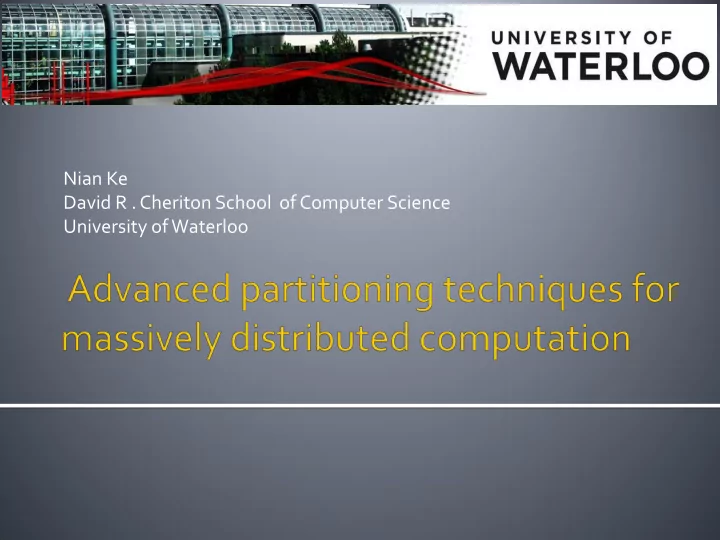

Nian Ke David R . Cheriton School of Computer Science University of Waterloo
Background MapReduce Model SCOPE Language and Cosmos system Advanced partitioning techniques Partial Partitioning • Hash-Based Partitioning • Range-Based Partitioning Indexed-based Partitioning Critiques and Discussion
• MapReduce Model • SCOPE Language and Cosmos system
Expertise are required to translate the application logic to MapReduce model in order to achieve parallelism. Code can be hard to debug and almost impossible to be reused. Complex application can become cumbersome to implement. Optimization of MapReduce jobs could be difficult.
• Partial Partitioning • Hash-Based Partitioning • Range-Based Partitioning • Indexed-based Partitioning
Even after query optimization, certain repartitions are still inevitable. However by carefully define the partition scheme, we could use partial repartitioning to replace full repartitioning. Partial partitioning could greatly reduce I/O, communication and memory burden while relieve the scheduler and decrease response time
If the input has already been hash partitioned by a, a great deal of resources would be saved
Range-Based Partial Partitioning could be used when input and output partition scheme share common prefix. Determine the partition boundary is important because it is crucial to reduce latency.
The StatCollector intercept the input and Boundary decision compute a histogram on the partitioning could not only be columns . Then the Coordinator compute a overall histogram and decide the overall made at compile time partition boundaries. but also running time. Although extra cost is needed, it could avoid skewed partition in certain cases which would lead to high latency
Optimizer would eliminate certain repartition when certain functional dependency is detected between input partition scheme and potential output partition scheme. Optimizer chooses to repartition data based on requirements of subsequent operators. Optimizer would consider partial repartition if certain structural properties are detected. Compromise may also occur.
Pushing partition scheme from one input to others: when inputs are partitioned in compatible way this method might be better. Heuristic Range partition: Obtaining a overall histogram buckets and generate boundary based on the overall statistics. Broadcast optimization: Based common prefix, partition the smaller input and for each partition of large inputs, send all partitions of smaller input to it.
The data is ranged- partitioned and sorted by {domain, host, top- level-directory} T1,T2,T3,T4,come from different period of time and different domain.
In the situation of terabytes of data, even the local repartition would be quite expensive We could compute a value pa(index number) utilize a stable sort to virtually “partition” the input data.
The paper did not provide detailed example and description for optimization opportunities for the N-ary operator. Due to commercial reason, the paper only provides relative measurements for the experiment results. Network environment for the experiments is not mentioned.
No example and experimental results were given for expensive N-ary operation like join. All of these advanced partitioning techniques and even the whole optimizer rely heavily on structural properties of the input stream.
Recommend
More recommend